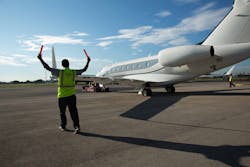The U.S. aviation industry has a severe shortage of aviation technicians and pilots, and a coalition of industry groups is now working with federal lawmakers to address the crisis. If this trend continues, the efficiency of the national aviation system and growth of one of the most important sectors of our economy could be undermined.
The “2019 Boeing Pilot & Technician Outlook” – an annual industry forecast of personnel demand – projects that 804,000 new civil aviation pilots and 769,000 new maintenance technicians will be needed to fly and maintain the global aircraft fleet over the next 20 years. The forecast is inclusive of the commercial aviation, business aviation and civil helicopter industries. This demand will stem from a mix of fleet growth, retirements and attrition.
In simple terms, this means that approximately 10,000 new pilots must enter the workforce each year to keep pace with demand and retirements. However, according to Federal Aviation Administration (FAA) data, less than 5,500 Airline Transport Certificates were issued during the first 11 months of 2018. Failure to produce more pilots will ultimately imperil small communities, which are most vulnerable to the loss of air service.
The consulting firm Oliver Wyman forecasts that demand for aviation maintenance technicians will outstrip supply by 2022. According to the Aeronautical Repair Station Association (ARSA), more than two-thirds of U.S. companies responding to a 2019 member survey reported vacant technician positions. This not only drives up overtime and training costs, but prevents new business development. ARSA projects the technician shortage is costing the U.S. aviation maintenance industry $118.416 million per month in lost revenue.
In addition, both aviation and business experts conclude that the pilot scarcity is disrupting both commercial airlines and business jet operators, causing labor costs to soar and profitability to decline. With workforce demand outpacing supply, the aviation industry faces serious financial headwinds from rising pilot costs and labor-related growth constraints.
Last September, the Senate Appropriations Committee recommended $5 million in funding for aviation technician and pilot education grant programs. This is half the amount approved in the FAA reauthorization law of 2018, which requires funding through the annual appropriation process. While the House Appropriations Committee voted to recommend a full $10 million in funding last June, Congress must approve a final version of the Transportation Housing and Urban Development bill before it can be signed into law by the president.
A coordinated effort across the global aviation industry is needed to create effective workforce development programs and direct pathways to a wide range of professional and technical careers. Workforce diversity is not only a business trend, but attracts top talent and offers companies a competitive advantage. As several hundred thousand pilots and technicians reach retirement age over the next decade, innovative solutions are needed to inspire and recruit the next generation of aviation professionals.
Many air carriers, and even airborne law enforcement agencies such as U.S. Customs and Border Protection, have forged successful partnerships with top universities to train and recruit future pilots. The business aviation industry must adopt a similar model to coach, mentor and empower students interested in full-time aviation careers.
To date, more than 40 leading aviation organizations have endorsed full funding of the two workforce development grant programs backed by the House and Senate. To meet growing demand for aviation employees, these initiatives call for developing high school aviation science, technology, engineering and math curriculum, as well as supporting aviation maintenance technician training.
For example, the program for technicians supports a wide range of recruitment and training activities. Intended to incentivize collaboration between key stakeholders, grant applications must be jointly submitted by a business, union, school or state/local governmental entity.
According to ARSA, grants may be used to:
- Establish new educational programs that teach technical skills used in aviation maintenance, including purchasing equipment, or to improve existing such programs
- Establish scholarships or apprenticeships for individuals pursuing employment in the aviation maintenance industry
- Support outreach about careers in the aviation maintenance industry to primary, secondary and post-secondary school students; or to communities underrepresented in the industry
- Support educational opportunities related to aviation maintenance in economically disadvantaged geographic areas
- Support transition to careers in aviation maintenance, including for members of the Armed Forces
- Enhance aviation maintenance technical education or the aviation maintenance industry workforce
The grant program for pilots also supports the creation and delivery of curriculum designed to provide high school students with aviation education that prepares them to become aircraft pilots, aerospace engineers or unmanned aircraft systems operators. Additionally, it provides for the professional development of teachers using the curriculum.
While authorization of these grant program marks a significant step forward, Congress must take action for the funding to be disbursed. As a launching pad, airport businesses should initiate dialogue with other community stakeholders regarding the joint grant program application and how to creatively use federal money. This process involves private sector companies, labor and pilot organizations, schools and governmental entities working together to address the challenge.
Finally, the growing diversity of aviation personnel will also require airport businesses to have cross-cultural, cross-generational and multilingual skills to engage future pilots and technicians. There is also significant opportunity to attract more female candidates to address the looming labor shortage.
For example, women currently make up just over 2 percent of the approximately 286,000 certificated airframe and power plant mechanics in the U.S. In addition, of the approximately 609,300 pilots in the nation, only 7.01 percent are women. Organizations such as the non-profit Women in Aviation International are dedicated to the encouragement and advancement of women in all aviation career fields and interests.
To address the workforce shortage, airport businesses must take a leadership role in advocating for federal funding, establishing scholarships and mentoring programs, providing training and apprenticeship opportunities, and attracting and retaining a diverse workforce. Reaching a diverse and new audience of future pilots, aviation technicians and other aviation professionals requires a collaborative effort among schools, local government entities, businesses, trade associations and labor organizations.
Ultimately, these efforts must happen to secure America’s global leadership in the aviation and aerospace sectors, fuel the national economy and maintain the efficiency of the U.S. airspace system.
Curt Castagna, president and CEO of Aeroplex/Aerolease Group, is a member of the Los Angeles County Airport Commission, president of the Van Nuys and Long Beach Airport Associations, and board chair of the National Air Transportation Association. A certified private and instrument-rated pilot, he has instructed courses in aviation administration at Cal State Los Angeles for over two decades.





